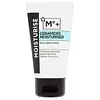What's inside
What's inside
 Key Ingredients
Key Ingredients

 Benefits
Benefits

 Concerns
Concerns

 Ingredients Side-by-side
Ingredients Side-by-side

Water
Skin ConditioningAloe Barbadensis Sprout
HumectantCetearyl Alcohol
EmollientPolysorbate 60
EmulsifyingSqualane
EmollientPrunus Armeniaca Kernel Oil
MaskingVitis Vinifera Seed Oil
EmollientSimmondsia Chinensis Seed Oil
EmollientGlycerin
HumectantCamellia Sinensis Extract
AntioxidantDimethyl Sulfone
SolventHelianthus Annuus Seed Oil
EmollientCaprylic/Capric Triglyceride
MaskingHydrolyzed Milk Protein
Skin ConditioningAllantoin
Skin ConditioningPiroctone Olamine
PreservativeTetrahexyldecyl Ascorbate
AntioxidantPanthenol
Skin ConditioningPolygonum Cuspidatum Extract
Skin ConditioningGlyceryl Caprylate
EmollientPyrus Malus Pulp Extract
Skin ConditioningTocopherol
AntioxidantHumulus Lupulus Extract
AntimicrobialWater, Aloe Barbadensis Sprout, Cetearyl Alcohol, Polysorbate 60, Squalane, Prunus Armeniaca Kernel Oil, Vitis Vinifera Seed Oil, Simmondsia Chinensis Seed Oil, Glycerin, Camellia Sinensis Extract, Dimethyl Sulfone, Helianthus Annuus Seed Oil, Caprylic/Capric Triglyceride, Hydrolyzed Milk Protein, Allantoin, Piroctone Olamine, Tetrahexyldecyl Ascorbate, Panthenol, Polygonum Cuspidatum Extract, Glyceryl Caprylate, Pyrus Malus Pulp Extract, Tocopherol, Humulus Lupulus Extract
Water
Skin ConditioningAluminum Starch Octenylsuccinate
AbsorbentGlycerin
HumectantPropylene Glycol
HumectantCetearyl Alcohol
EmollientPropanediol
SolventGlyceryl Stearate
EmollientButylene Glycol
HumectantSorbitan Stearate
EmulsifyingDimethicone
EmollientIsohexadecane
EmollientSodium Polyacrylate
AbsorbentPhenoxyethanol
PreservativeBetaine
HumectantCaprylyl Glycol
EmollientXanthan Gum
EmulsifyingPEG-100 Stearate
Sodium Lauroyl Lactylate
EmulsifyingSodium PCA
HumectantSodium Lactate
BufferingDisodium EDTA
Sodium Hyaluronate
HumectantTocopheryl Acetate
AntioxidantArginine
MaskingAspartic Acid
MaskingPCA
HumectantCeramide NP
Skin ConditioningGlycine
BufferingAlanine
MaskingCholesterol
EmollientCeramide AP
Skin ConditioningPhytosphingosine
Skin ConditioningSerine
MaskingValine
MaskingCarbomer
Emulsion StabilisingEthylhexylglycerin
Skin ConditioningIsoleucine
Skin ConditioningProline
Skin ConditioningThreonine
Histidine
HumectantPhenylalanine
MaskingCeramide EOP
Skin ConditioningWater, Aluminum Starch Octenylsuccinate, Glycerin, Propylene Glycol, Cetearyl Alcohol, Propanediol, Glyceryl Stearate, Butylene Glycol, Sorbitan Stearate, Dimethicone, Isohexadecane, Sodium Polyacrylate, Phenoxyethanol, Betaine, Caprylyl Glycol, Xanthan Gum, PEG-100 Stearate, Sodium Lauroyl Lactylate, Sodium PCA, Sodium Lactate, Disodium EDTA, Sodium Hyaluronate, Tocopheryl Acetate, Arginine, Aspartic Acid, PCA, Ceramide NP, Glycine, Alanine, Cholesterol, Ceramide AP, Phytosphingosine, Serine, Valine, Carbomer, Ethylhexylglycerin, Isoleucine, Proline, Threonine, Histidine, Phenylalanine, Ceramide EOP
 Reviews
Reviews

Ingredients Explained
These ingredients are found in both products.
Ingredients higher up in an ingredient list are typically present in a larger amount.
Cetearyl alcohol is a mixture of two fatty alcohols: cetyl alcohol and stearyl alcohol. It is mainly used as an emulsifier. Emulsifiers help prevent the separation of oils and products. Due to its composition, it can also be used to thicken a product or help create foam.
Cetearyl alcohol is an emollient. Emollients help soothe and hydrate the skin by trapping moisture.
Studies show Cetearyl alcohol is non-toxic and non-irritating. The FDA allows products labeled "alcohol-free" to have fatty alcohols.
This ingredient is usually derived from plant oils such as palm, vegetable, or coconut oils. There is debate on whether this ingredient will cause acne.
Due to the fatty acid base, this ingredient may not be Malassezia folliculitis safe.
Learn more about Cetearyl AlcoholGlycerin is already naturally found in your skin. It helps moisturize and protect your skin.
A study from 2016 found glycerin to be more effective as a humectant than AHAs and hyaluronic acid.
As a humectant, it helps the skin stay hydrated by pulling moisture to your skin. The low molecular weight of glycerin allows it to pull moisture into the deeper layers of your skin.
Hydrated skin improves your skin barrier; Your skin barrier helps protect against irritants and bacteria.
Glycerin has also been found to have antimicrobial and antiviral properties. Due to these properties, glycerin is often used in wound and burn treatments.
In cosmetics, glycerin is usually derived from plants such as soybean or palm. However, it can also be sourced from animals, such as tallow or animal fat.
This ingredient is organic, colorless, odorless, and non-toxic.
Glycerin is the name for this ingredient in American English. British English uses Glycerol/Glycerine.
Learn more about GlycerinWater. It's the most common cosmetic ingredient of all. You'll usually see it at the top of ingredient lists, meaning that it makes up the largest part of the product.
So why is it so popular? Water most often acts as a solvent - this means that it helps dissolve other ingredients into the formulation.
You'll also recognize water as that liquid we all need to stay alive. If you see this, drink a glass of water. Stay hydrated!
Learn more about Water